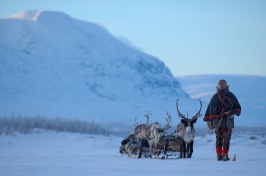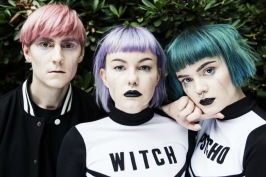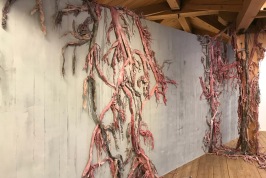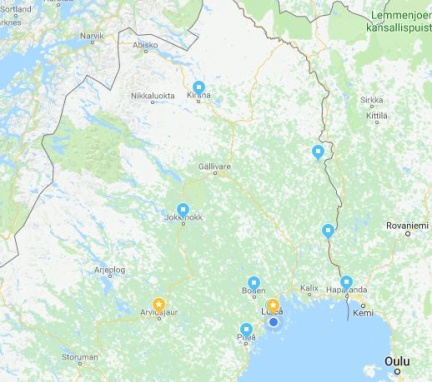INTERESTING FACTS ABOUT NORRBOTTEN
The network of artist-in-residence programmes are based in different municipalities of Norrbotten, a region named due to its geographic position: north of the Gulf of Bothnia overlooking the Baltic Sea. Broadest and northernmost county of Sweden and crossed by the Arctic Polar Circle, it borders Finland (northeast), Norway (northwest) and it is part of Lapland and the Barents region. Its climate is subpolar marked by long, rigid but dry winters and warm enjoyable summers.
Please find below a short selection of interesting facts about the area:
- Territory. Norrbotten’s territory is predominantly flat with mountainous areas towering near the Norwegian border. Not far from Kiruna, the Kebnekaise and Sarektjåkkå peaks rise up to around 2000 meters above sea level.
- Nature. Is a prevailing element within the region dominated by endless forests stretching as far as the eye can see. According to the season, nature can sustain the forestry industry besides regular hunting and fishing activities. Mushrooms and berries are particularly abundant between late summer and autumn. From September/October until April/May the Northern Lights can be clearly seen in the sky.
- Water. Is literally everywhere, whether as sea, lakes, rivers or waterfalls and it's an important source of hydroelectric power. For example, the amount of energy harvested from the Lule River accounts for 10% of the electricity used in the whole of Sweden. The side effect of this lies in the fact that many river exploitations are still being conducted – and not without conflicts. Today, the Pite River is the only one left untouched: flowing within the municipality of Älvsbyn, it boasts the biggest rapids in Europe, Storforsen.

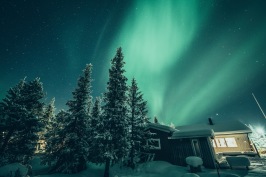
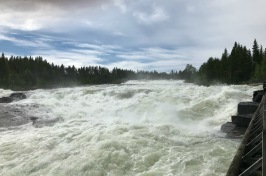
- Mining. Represents one of the most important industrial sectors, particularly in Kiruna and Malmberget (Gällivare), hosting respectively an underground and an open-pit mine. Both towns have become famous due to their process of re-location further away from the mines. LKAB ( the company owning the mines), have invested large sums of money to move and preserve most of the historical and iconic buildings such as the church of Kiruna (built in 1906). Despite investment, moving some of the buildings have been impossible due to architectural and structural limitations. For example, the townhall of Kiruna, will be demolished and substituted by the new Kristallen (by architect Henning Larsen) in the new city centre. The moving plan will be finished in about 20 years. Overall, the long moving plan is involving intense efforts not just materially but also emotionally for local residents.
- Technology. Significantly increased when the city of Luleå was one of the sites to win the competition when Facebook decided to build new data-centres in Europe. This field is supported by the Technical University of Luleå (LTU – Luleå Tekniska Universitet). More recently, in Boden, many bit coin companies’ data-centres have been opening within the historical and unused military buildings.
- Sport. Hokey and basket are the two main sports supported by the Norrbottnian community, but in general people are quite active practicing different activities such as: cross country and downhill skiing (kick and dog) sledding, climbing, hiking, biking and skating.

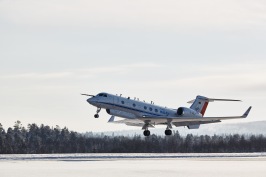
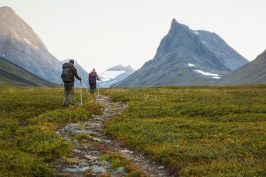
- Sami. The indigenous population that originally inhabited the Northern part of Europe still lives in Norrbotten spread across 32 villages in the region. Long and delicate issues mark the history of the Sami people, who were discriminated, segregated and disfavoured for a long period of time until the second part of the last century. Just recently they have finally been reintitled to use their language and culture, defending their rights and heritage. Nowadays, around 4000 Sami people are still reindeers's owners and breeders. The Sami have their own popularly-elected Parliament (the first Swedish election occurred in 1993), with its headquarters in Kiruna and minor offices in Jokkmokk. Their work is mainly dedicated to support Sami issues such as reindeer husbandry and herding, trading and culture.
- Culture. Diversity and multiculturality are "a thing" in Norrbotten. Just like in the rest of the country, the region embraces a diverse spiritual context and different creeds mainly due to significant immigration coming to the country in recent times. On this heterogeneous background, the cultural scene is quite lively in the fields of literature, music and visual arts.
